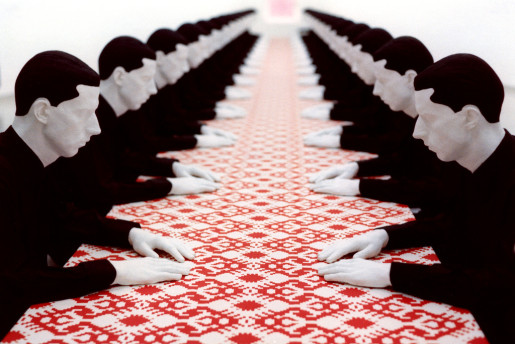
Katharina Fritsch
There is an increasingly bizarre sense of body, sexuality, and health image reflected back at people in the West from their cultural products. The evolution about ideas of “health” are, of course, ideological, but coupled to this is an increasingly dysmorphic sense of body and how this manufactures desire and props up the White male world in a delusionary state of percieved superiority.
Let me backtrack just a bit. There is a shift that has occured over the last forty years, and probably it began more like fifty or even sixty years ago, but more acutely since the 70s and that is the emergence of a militarized aesthetic for beauty. At least for male beauty. The corresponding shift for women has been in a sense the Playboy playmate ideal. But this is grossly over simplified. And one of the issues in play here is race, and the other is class. But the aesthetic for men cuts across all this. I suspect (as I’ve written before) that the rise in steroid use (and its availability) connected to the extreme mediation of culture in general by the Pentagon and U.S. State Department is the factor least examined. The propaganda wing of the U.S. government has had much greater effect than anyone seems to want to look at.
The proliferation of private gyms was fueled by early health and fitness figures like Jack LaLanne and Vic Tanny, and the body building side of it by Joe Gold, and Joe Weider who with his publishing empire and the marketing he implemented for bodybuilding as a *sport* changed the landscape for male beauty as much as anyone. But the conditions were perfect for what Weider simply sniffed out ahead of anyone else.
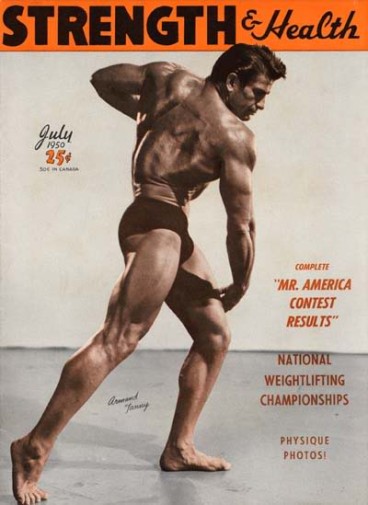
Alan Sears noted:
“Very early in the 20th century, for example, the British government was worried that its fighting capacity in the Boer war was compromised by the low level of health and fitness among working-class men. They formed the Inter-Departmental Committee on Physical Deterioration, which issued a report calling, among other things, for more physical training in schools.
Physical education, then, was not rooted in a general desire for healthy minds and healthy bodies, but an imperative to increase national military capacity. Specialists in schools and gyms developed training methods that were focused not on providing people with the resources and knowledge to live well in their bodies, but rather preparing them to meet the performance requirements of employers and the military.”
LaLanne it should be noted was something of a genuine phenomenon and a sincere advocate for nutrition and was probably the first public figure to consistently denounce fast food, and food additives. He as also a remarkable athlete whose physical feats of strength remain quite impressive, the carnival marketing notwithstanding (including his swimming, handcuffed, from Alcatraz to Fisherman’s Wharf in San Francisco in 1955). In any event, there were other early health gurus, from the Southern California legend Gypsy Boots, to Paul Bragg and Jay Kordich. But it was the 1970s that signaled the deeper societal shifts that affected the public consciousness about health and beauty.
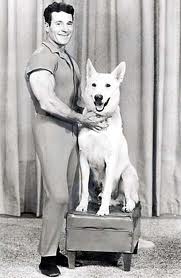
Jack LaLanne, 1960s
The destruction of union work that was already underway when Reagan became President in 1981, was intensified and completed over the next decade. The general sense of both psychic and material insecurity that came with the end of the Viet Nam War, and the government’s slashing of benefits, was accompanied by several other cultural factors. The civil rights movements, and feminism most directly. The beginning of outsourcing jobs, and the spike in technological replacements for workers corresponded to the consolidation of capital, the corporatizing of Western capital. This is a long complex discussion, and I’m trying to sort of zero in on a couple issues that seem less analysed as both cause and effect. The collective effects of these early signs for what came to be today’s crises in the West, economically and culturally, was –to be put it in short hand — the rebranding of the American dream. Globalization, the rise of the trans-national corporation, and absolute destruction of rights for labor resulted in a need for the U.S. government to reboot it’s propaganda machine. Viet Nam was not going to be repeated. Perception is everything. Marketing was in the ascent and the watershed phenomenon of *branding* had shifted the focus for propaganda, and the state realized that more resources should be ear marked for propaganda, for selling this increasingly alienated population on the idea of “patriotism” and “freedom” and of “American Exceptionalism”. The emphasis shifted to the *individual*. The individual had to prepare him (and her) self for ‘battle’ in the free market. Winners and losers. Where once the assumption had been to fight poverty and inequality with social collective action, the Reagan era privitized this, personalized it, and it was the responsibility of the individual to go forth into that great battleground of Capitalism and beat off the competition. As Al Davis famously said, “winning isnt everything, it’s the only thing”.
The cultural sphere reflected the same forces of consolidation and marketing. Where in the 1980s there were hundreds of seperately owned media, today there are essentially only eight. The story of marketing is well told in Adam Curtis’ BBC documentary Century of The Self. But something else was happening alongside these economic and political forces and that was the role of propaganda. The culture industry. So, the aesthetic models for beauty adjusted, or were adjusted. To go forth and do battle meant one better be prepared. And the best preparation was to re-shape oneself as a societal warrior. This also fitted in well with the basic Puritan ethos of the U.S., where any chance at self laceration was welcome. Now, the health notion and physical fitness, in the U.S. took a distinct turn early with John F. Kennedy’s famous physical fitness program.
This proved to be more symbolic than actual, of course, given the paradoxical reality that the U.S. is now among the most obese nations on earth, and one of the least healthy. Perception is everything. If there is less actual physical work, there is more focus on self image. The steady rise in poverty and collective anxiety is mediated by the embrace of and deepening of identification with the products of the culture industry. Not just Hollywood film and TV, but big business sports, and the government itself all sell a narrative. This propaganda narrative, the master narrative, is one that glorifies power and violence. The public today, where wealth is increasingly polorized, clings to this narrative in an almost desperate fashion. The evolution of this narrative, in its current state, can be traced back to the paradigm shifts that began in the 70s. And it is this narrative that has today arrived at, inevitably, a state of total irrationality. And again, the bottom line reads *violence*. The narrative in place is one of white supremicism, and patriarchy. As the ever growing need of the state to control the ever growing surplus population of the poor, mechanisms of control and domination must keep pace. Against this backdrop then, it makes sense to examine the destination arrived at in this privitized individualized sense of self that imprints consciousness in the West.
Alan Sears again….
“The models of fitness we aspire to through training actually have very little to do with our health. The extreme worlds of fashion modelling, bodybuilding, and elite athletics have established unsustainable standards for body image organized around hierarchies of gender, race, sexuality, and class. These bodies are built through cycles of bulking and cutting, supplementation, food and water deprivation, and extreme training regimes that are simply incompatible with a balanced life of good physical and mental health. Add in the photoshopping that accompanies professional photoshoots and you have unattainable standards projected everywhere. Our own bodies necessarily feel rather flawed in comparison.”

Ben Aronson
There is no way to separate the elements at work here. Economic anxiety, and marketed fear work with the resurgent racism of public discourse. The neo-liberal project is one of snitching, shaming, and stimatizing, as well as the valorizing of violence. The cultural zero sum game of today’s police state means the public cannot win, it can only embrace slavary or go mad. Against this reality there is the last gasp addiction to scapegoating, and to symbolic forms of conquest. This symbolism, however, finds itself in a return to private personalized forms of conquest.
And desire, and sexuality, is collapsed into the narrative in ever more pathological ways.
“A 1997 National Institute of Justice study estimated that between one-fifth and onequarter of women are the victims of completed or attempted rape while in college (Fisher,
Cullen, and Turner 2000).”
And…
“Fraternities control every aspect of parties at their houses: themes, music, transportation,
admission, access to alcohol, and movement of guests. Party themes usually require women
to wear scant, sexy clothing and place women in subordinate positions to men. During our
observation period, women attended parties such as “Pimps and Hos,” “Victoria’s Secret,” and
“Playboy Mansion”—the last of which required fraternity members to escort two scantilyclad dates. Other recent themes included: “CEO/Secretary Ho,” “School Teacher/Sexy Student,”
and “Golf Pro/Tennis Ho””.
‘Sexual Assault on Campus’, Armstrong, Hamilton, Sweeny.
This is the white affulent world of fraternities and sororities at U.S. universities.
http://www.brobible.com/life/article/10-girls-at-every-fraternity-party
I wrote last posting about propaganda that especially targeted the educated (primarely white) 20% of the population. These men are the future CEOs and business executives, politicians and educators of U.S. society. It is difficult not to see the significance of the aesthetics of all this and how they link directly to the *boot camp* notion of beauty and the selling of desire. In the age of information technologies, the social commons is in cyber space. The control exerted on public space is militarized, the shrinking possibility of social interaction outside the male regulated venues (at the University level) is obvious. This is a WHITE world. And it is an affulent world. And it is reinforced by Hollywood at every turn. I happened to watch a couple episodes of Aaron Sorkin’s new show The Newsroom this week. In one episode, a “B” story involved an Occupy Wall Street figure being interviewed by star news anchor Jeff Daniels. After ridiculing the Occupy movement, Daniels informs the young woman, “Capitalism works because it has accountability”.
This is the message. Inequality is your own fault. Privilege is a topic never addressed. The less fortunate are treated with care, but the cause of their lower status, their poverty or inequality is never examined. Capitalism has accountability. The other “B” story involved Troy Davis. I neednt go into the slimy details because I suspect you can guess. The “A” story involved two news reporters (young) travelling to Africa and witnessing the brutal shooting of a young black African child. This caused great trauma for the young reporters. So, much like Orange is the New Black, black characters are props for telling the story of white characters. For exhibiting white virtue and compassion, and yes, suffering.

So, if one examines the image of the male ideal today, one sees a powerful physically dominant figure, a soldier and warrior. There are of course countless contradictions to be seen in all of this. But it is a cultural zero sum game, again. For every lack of shredded abs, you can add additional zeroes to the character’s bank account. Jeff Daniels character has symbolic 21 inch biceps (as he says, “I get paid what the market will bear, therefore I get paid what I am worth”). We can only assume Sorkin feels much the same.
From the same Armstrong, Hamilton, Sweeny paper:
“Party rape is accomplished without the use of guns, knives, or fists. It is carried out
through the combination of low level forms of coercion—a lot of liquor and persuasion,
manipulation of situations so that women cannot leave, and sometimes force (e.g., by blocking a door, or using body weight to make it difficult for a woman to get up). These forms of
coercion are made more effective by organizational arrangements that provide men with
control over how partying happens and by expectations that women let loose and trust their
party-mates. This systematic and effective method of extracting non-consensual sex is largely
invisible, which makes it difficult for victims to convince anyone—even themselves—that a
crime occurred. Men engage in this behavior with little risk of consequences.”
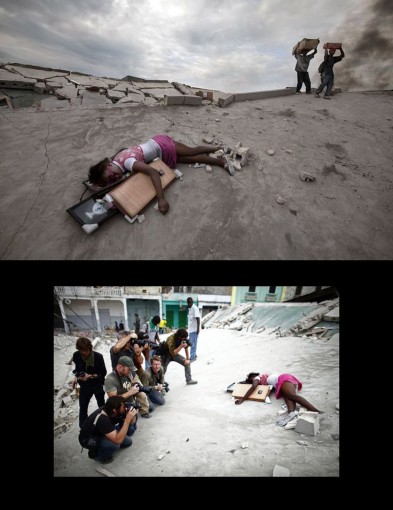
15 year old Fabinne Cherisma shot by police, Haiti, photo by Nathan Weber
The white supremicism that has resurfaced so dramatically in popular culture, and through the pseudo-progressive racist thought of figures such as Zizek, not to mention the more openly right wing pundits one sees on FOX news, is intertwined with just this sort of structural reality for the more affulant class. It cannot be tweezed apart from the colonial narrative at work in Orange is the New Black, or the liberal racism of The Newsroom, nor does it really contradict in any way the more vulgar expressions found in a host of TV cop shows. The protagonists of Graceland or Hawaii Five O are just grown up frat boys. The business of sports, which extends to college programs and high school, is simply the exact same reproduction of these white ruling class values. Star athletes are treated with deference even if black, and the average athlete as props for the great and broader narrative that is the master discourse. Star athletes are granted dispensation, and get to the join the symbolic BIG frat house. When the Jerry Sandusky scandal broke, and it was clear the entire Penn State program was implicated, the media was puzzeled as to how to frame the story. A few bad apples didn’t quite hold, because there were too many of these apples. Lip service was paid to the lessons supposedly being learned and then the story gradually faded away. Notwithstadning the draconian crimes of Sandusky and Joe Pa, the student body at Penn State largely supported Paterno and even showed up to protest his *unfair* treatment. Now one of the less obvious realities in all this is that the hegemony of the *white* narrative serves to marginalize radical voices. Queer culture, unless male and white and educated, is given at best token visibility, and women artists can count on an additional set of difficulities in gaining recognition, unless they adhere to (and more violently so) the values of the white supremicist society. The arbiters of culture will assign importance to those writers and filmakers who reflect the values of the white frat boy party rape warriors.

Judy Fox
If one examines mainstream culture, especially in the dominant art forms of film and TV, what is obvious is that the sensibility of the frat boy warrior (either with six pack abs, or MORE money or power) is in evidence in almost every single show or studio film. Now a couple other thoughts on all this; the question of race is fascinating, and black voices actually are almost non-existent. Jamie Foxx can play the president, but then Foxx embodies the same sensibility as most white Hollywood actors. Black women are even harder to find in any sense outside that of props, either sexual (ho’s) or as aspiring white people (Condi Rice stand ins). Any exceptions one can find only serves to prove the point. Which should be obvious. Now, the question of high and low white culture has its share of cross pollinating as well. Those muscle magazines of Vic Tanny and later Joe Weider and others, were targeting working class teenage boys. It is the same audience targeted by Mavell Comics and DC comics. Steve Reeves was just another version of Batman. But as this model of male potency evolved, the privitized individual warrior in the great marketplace of Capital, battling for success, working to “improve” himself, began to consume tropes from both the comic book aesthetic as well as the (in theory) more elite narratives of an Updike or Cheever. As the University system became increasingly colonized by kitsch genre product, now treated seriously (I knew a Harvard grad TV writer who wrote his thesis on Gilligan’s Island) and as the collective anxiety of the post Viet Nam Reganomics white society of corporate America was being presented in more strident forms, the resulting images were highly contradictory and visually dysfunctional. The codes couldnt hang together, somehow. The anti heroes of 1940s film noir seem of preternatural clarity when viewed against Top Gun, say. Tom Cruise became a sort of avatar for the post Reagan shining city on a hill male ideal, the boy scout crossed with a fraternity brother by way of an out crossing to gay porn actors like Jack Wrangler, and through all was the sense of this Scientology following short guy who nonetheless consistently conveyed the obsessive career drive that was the real core of his cross gender appeal. That Cruise made his breakthrough in a white suburban sex-com with a pimping theme sort of makes sense.
That his biggest hit was the military fantasy Top Gun, a film extensively used by military recruiters, is also not exactly a surprise. The homo-erotic sub-text is, again, not unexpected.
The photo of the fifteen year old Haitian girl above is given a narrative context here: http://www.colorsmagazine.com/stories/magazine/86/story/this-is-15-year-old-fabienne-cherisma-shot-dead-by-a-policeman-after-lootin
The underclass are only props. That all narrative is mimetic, and all stories crime stories (and probably parables of the Mother’s touch per last posting) means that the harvesting of stories of the *other* will be have to involve some form of filtering by the dominant class, by the harvester. Piper Kerman’s story isn’t really HER story. She isnt very interesting. It’s the story of life in prison. *Prison* is the main character. But it’s not really the main character, and it’s not really prison. The actual concrete historical story of punishment isn’t going to be told, just as, really, Fabienne Cherisma’s story isn’t really going to be told, because to tell it would mean telling the story of Haitian oppression, of slave revolts, and of sugar, and of Jean Etienne Bore, and of Toussaint L’Ouverture. Haiti is easier to see as a failed state in need of T shirt factories and the help of Sean Penn and Bill Clinton. Clinton was really the first frat boy president. The Lewinsky narrative played out like a chapter from the “Brobible”.
Props. Aaron Sorkin can write a story of generic Africa, and a generic school and a generic shooting by black *rebel* cattle thieves (no less) with a young pretty white news reporter reading children’s stories to poor ‘ready to die for Whitey’s’ story little African boy. This allows the audience to feel as if somehow their own feelings of superiority are validated. Or the Troy Davis subplot. The liberal do-good producer being lectured to by Jeff Daniels about the rule of law, appeals, and how, well, a jury of his peers DID find him guilty. This is white exceptionalism. Does Sorkin really think Troy Davis was guilty?

Denise Austin
The idea of health as it evolved is also full of odd paradoxes and contradictions. It is also relevant that the loss of union security, of the traditions within families, and the community formed around those traditions that had disappeared only contributed to the feelings of alienation, and to the selling of junk food as somehow linked to progress. Community stability assists in eating habits that have, at the least, some traditional wisdom passed down as part of food rituals. The rise of a new moral but ripped warrior frat boy was inseperable from a construction of masculinity that demanded red meat, a propensity to womanize, and the witholding of one’s real emotions, the better to save them for mother (or your horse, or pistol, or dog). Or, for yourself. And perhaps that’s the deeper truth, here. What one ate reflected who you were in the same way that the car you drove reflected who you were. Male potency links to symbolic forms, to surrogate symbols of sexual mastery.
It is possible that the figure of Joe Friday looms larger in the history of US consciousness that one previously realized. Jack Webb, a strange and somewhat marginal figure in Hollywood with unquestionable savant talents, found his calling in the role of Friday and in the decades long franchise Dragnet. Webb, whose personal life was rife with rumors, seemed to convey, with just the right amount of cloaking, a certain innate sadism. Sgt.Friday was a bachelor, isolated, emotionless, and cold. Just the facts, ma’am. One could argue a direct line from Friday to Mr. Spock. And to HAL and the Terminator. There is no other culture that has shown such repeated love of the emotionless character, sacrificing human feelings (or not having them to begin with), the better to stay in control of his surroundings. The misogyny one feels running through Dirty Harry to Dragnet (and indeed Eastwood is another Webb grandchild) is that of the distant hero, unable to accept love or give it. The hero who only expresses himself through violence. The man without a woman, but WITH a gun. White men.
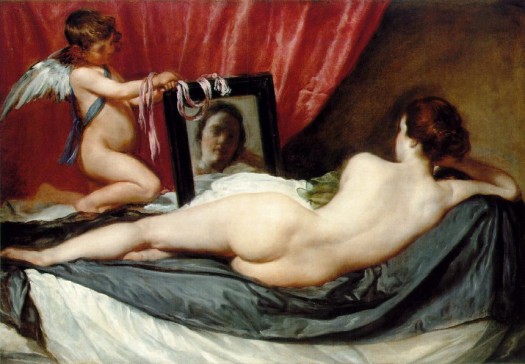
Diego Velazquez
The sense one gets of party rape on college campuses is of an enactment of a toxic drama of white male enforcement of privilege and power. It is the sadism born of a deep core fear and insecurity. White privilege is in growing need of more regular transfusions of symbolic and real valorizing. Dick Cheney must bomb the shit out of Iraq. The fraternity brother must force that freshman to blow him before she throws up. The constant degrading of the ‘other’. The constant display of superiority.
Health was fetishized. For men, for white men, the notion of health is connected at its most fundamental level with a malformed or half developed narcissism. It is incomplete narcissim. The imperfections or truncated empathic dynamic with the mother (or core caregiver) breeds an intensification of the basic split in psychic formation. Without too elaborate a description here, for the purposes of this post, the repressed sense of inadequacy results in the need to control other people’s perceptions of you, and this unconscious fear or being found out. The evolution of “health”, a sort of Purtianical almost authoritarian sense of physical perfection that is inseperable from moral purpose. It was found in the Aryan purity so beloved of National Socialism. The health conscious, at least in the West, develop a parallel moral health. It is the Cotton Mather syndrome in the U.S. The fear of germs and of hidden infection and contagion is associated with those less perfect, or of percieved inferiority (biologically). This is a fascist personality. The white male narcissist, fighting his own repressed knowledge of being defective and unable to match his ideal sense of being a man, projects this anger of his own failure out on those obviously (to him) even further from the ideal, and this is coupled to a deep hatred of women, the most physically inferior and ‘lacking’. The desire for exaggeration in strength and power (even if its only the power purchased with money) is built on the constant need to *have this superiority seen* by others. White men do not look to achieve perfection in isolation. The loner is only a disguised social butterfly. The preening male youth sexting their time away, or MySpace-ing it, is the new self branding. For women, the gaze of the male power source defines self worth. Again, to view The Newsroom is to watch this entire vast narrative played out in kitsch form. Race and gender inequality is normalized and sanctioned in these corporate products.

Rockefeller Center, Lee Lawrie, design
But as I say, health is ideological in presentation. Vitality and potency (for this is about men) is equated with physical power and also with an overcoming and an ordeal. No pain no gain. If Leni Riefenstahl’s Olympia hammered away the theme of Aryan physical perfection in sport (including women, albeit BLOND women), the current media depictions of male power suggest all that was missing in Riefenstahl was an acute sadism. Health is physical vitality and strength. In fact, obviously, acute steriod use and dieting and obsessive training is not healthy, but that’s not the point. The point is that there is a moral purpose attached. And it is a single minded one dimensional moral purpose: white supremicism and cleanliness. What is being conquered is UNcleanliness (the poor, blacks, women, etc). Interestingly, in Riefenstahl’s last work, her photo essay on the Nuba tribe in Africa, the jew had been replaced by modernity, civilization. This was a return of the noble savage. Fpr U.S. popular culture, Batman and Superman are idealized figures, but really it is the celebrity of Stallone or Schwarzenegger (and it is hard not to remember his father was a Nazi provincial policeman) or even the frat boy perfections of a Brad Pitt or Ben Affleck. There is a curious confluence of this frat boy figure (puer aeternus) with the prolonging of adolescence, and with the emotionally distant loner, bachelor, and gunslinger (Jack Webb to Eastwood), and with the self sacrificing moral purpose of the U.S. Marine. Actors like Ryan Gosling contain bits of all three, and in all these cases, the machismo has started to tilt in the homoerotic end of the spectrum. The narrative, though, has continued on a more emphatic pounding home of the moral purpose — and the frat boy sensibility is also a fan sensibility. In fact, so deep is the fan culture, so permeating, that the fan-geek is almost a new figure of white respect. Writers like Bill Simmons (who founded Grantland) is the love child of Hunter Thompson and Bill Clinton, by way of Perez Hilton. The “geek” fan is the appreciator of the status quo, the validator of the status quo. The new figures of health and potency seem to demand their footmen, their servants. Their boy fridays. If the Aryan Ideal of Riefensthal was a racialist Götterdämmerung figure, the Frat Boy Tom Cruise, or Ryan Gosling (former Mousketeer) need their fan hagiography.
Now, I think there is an important distinction to be made here regards Aryan cultural production, and a corrective to the confusion that Susan Sontag made about it. Here is a quote of Sontag, from 1974:
“Nazi art is reactionary, defiantly outside the century’s mainstream of achievement in the arts. But just for this reason it has been gaining a place in contemporary taste. The left-wing organizers of a current exhibition of Nazi painting and sculpture (the first since the war) in Frankfurt have found, to their dismay, the attendance excessively large and hardly as serious-minded as they had hoped. Even when flanked by didactic admonitions from Brecht and by concentration-camp photographs, what Nazi art reminds these crowds of is—other art of the 1930s, notably Art Deco.(Art Nouveau could never be a fascist style; it is, rather, the prototype of that art which fascism defines as decadent; the fascist style at its best is Art Deco, with its sharp lines and blunt massing of material, its petrified eroticism.) The same aesthetic responsible for the bronze colossi of Arno Breker—Hitler’s (and, briefly, Cocteau’s) favorite sculptor—and of Josef Thorak also produced the muscle-bound Atlas in front of Manhattan’s Rockefeller Center and the faintly lewd monument to the fallen doughboys, of World War I in Philadelphia’s Thirtieth Street railroad station.
Philadelphia 30th St. station World War 2 memorial. Actually, this is a World War II memorial from 1952. To an unsophisticated public in Germany, the appeal of Nazi art may have been that it was simple, figurative, emotional; not intellectual; a relief from the demanding complexities of modernist art. To a more sophisticated public, the appeal is partly to that avidity which is now bent on retrieving all the styles of the past, especially the most pilloried. But a revival of Nazi art, following the revivals of Art Nouveau, Pre-Raphaelite painting, and Art Deco, is most unlikely. The painting and sculpture are not just sententious; they are astonishingly meager as art. But precisely these qualities invite people to look at Nazi art with knowing and sniggering detachment, as a form of Pop Art.”
Now, first, Art Nouveau can just as easily be fascistic, in fact Id say the excessive superficiality and ornamentation is very much the expression of gratuitious privilege, it is the art of a leisure class. And Art Deco, in fact produced some of the best design of the 20th century. (“petrified eroticism”?). In fact Art Deco was linked to ideas of movement and progress. To speed and dynamism. One could argue there is a relationship between Marinetti and Italian futurism, and hence fascism, but no more than links between Riefenstahl and Rodchenko because both used cameras. I mention this because Sontag is speaking of Riefenstahl, and her confusion about the nature of what is reactionary is actually pretty harmful, critically speaking. Art Deco certainly tapped into the grandiosity of those paying for the commissions, and these captains of industry wanted an oversized sense of power on display. But this is a rather simplistic reading (and Sontag is repeatedly guilty of engaging with art in a way that valorizing themes and not dialectically, where form and mimesis enter), and in the deeper sense the ironic (which Sontag is basically correct about) sees excess as a virtue, the parodic as reason enough for approval, actually. The fascistic in art and culture today reflects the appeal that sadomasachism has for the U.S. public, raised for several generations on the S/M of cop shows and various ‘slave narratives’. Hitler equated domination of the masses with rape. Frat boy culture equates ‘party rape’ with their own entitlement and with their superior moral purpose (like Hitler, in fact). The dynamic of clean and unclean, the valorizing of physical ordeals (how many reality TV shows create ordeals for contestants to endure?), the worship of authority, of power, of, also, cruelty and punishment. Today’s fixation with punishment, however, feels like it has reached a point where it exists for its own sake. Violence for violence’s sake. The innocent get their doors kicked in, and are seen the way the Virgins were seen who Aztec priests tossed into the pit below. Someone has to be found, those Humvis and Kevlar vests need to get used, those displays of power, are the new sexual fetishes. I am sure both straight and gay porn will soon feature actors in SWAT team attire, visors down, kicking in the door.
The US never lost its Puritan past, however. Lurking beneath the Art Deco facades of Rockefeller Center there is always the American super ego. Cotton Mather didnt watch over the shoulder of Hitler, or Riefenstahl, so U.S. fascism feels more guided by sexual inhibitions, and hence its pornography is expressed through another layer of filter. Still, racism and the harvesting of culture that is outside the mainstream (street fashion, hip hop, or graffiti and low rider art) and is soon being reproduced in a cleansed form, duplicates the cleansing project of the Nazis. This is not the manufacturing of an ideal however, it is a flattering of an audience and their previously manufactured sense of self.

Von Gloeden, photog.
appx. 1900
In such shows, from Orange is the New Black, to The Newsroom, to Girls, to Sex and The City, and Six Feet Under, or etc—- important events are evoked in trival almost anti-symbolic ways, unatmospheric and with intentional triteness. The purpose of all of them is to flatter the intended bourgeois audience. The white audience. The white educated 20%. The liberal white class that imagine themselves tastemakers. They are shaping nothing in their fan adoration. They are simply the recipients of marketing techniques. It is clear today that no show can be too banal. The 20% function in much the same way the 80% do. The few genre products that actually demand an engagement, and there are not many (AMC’s The Killing, is one) are invariably short lived. In fact, The Killing was an Americanized version of a Danish series. There is little demand for originality, or depth. In fact it’s a handicap. And the biggest complaint heard today is that “its too slow”. All narrative is too slow. Any narrative is too slow. I have noted that even in shows (like Breaking Bad) that are only several seasons old, that whole episodes are essentially being replayed. A few cosmetic changes, but otherwise, the storyline is identical to an episode from two years earlier.
*photo above of ceiling fixture by William Eggleston.

That’s great
god Suntag really was not very bright and kind of a cretin though she had all these superficial attributes of the urbane
too slow – yes. nothing needs to make sense but one has to feel the speed. even expensive movies now use the ersatz handheld camera to give this sense of bumpiness like turbulence on a plane to make you feel time is passing. a smooth ride seems too slow. the first reality tv and cheap cooking shows noticed this 6 didnt matter what the content was, if the camera is shaking and people are running around it will get an audience. nowehere near what a soap dramedy will get, with the addictive formula, but not nothing.
Yes, one could do a whole analysis of steady cam and hand help filming, the destruction of location, coupled to quick edits…attention deficit edits……and there is a sense of urgency. There is this learned need to feel as if its all very urgent…..the clock is ticking. There isnt even a bomb…but the clock is ticking.
Sontag, yeah. I mean that essay on Riefenstahl is pretty bad, actually. She made some smart observations (especially on the Nuba , how civilization had sort of replaced the Jews) but then its never quite exactly right. Its right but its always not EXACTLY right, and she is so consistently undialectical. And so her conclusions are just empty and vague somehow.
プラダ prada 財布
i wrote on twitter at one point that sontag’s basic skill is belaboring the obvious. she specialized in a kind of diffuse thoughtfulness that stopped just short of actual analysis. but, who knows, her particular niche within the opinion-production media factory may have been beneficial insofar as yer average new yorker reader getting cliffnotes adorno from her is still a step up from the usual.